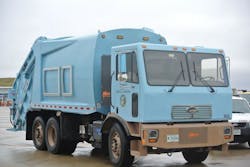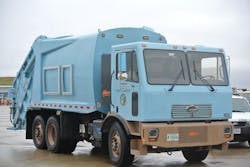[You can view pictures of the vehicles involved in that ride-and-drive by clicking here.]
Though ostensibly an event aimed at airport operations, the appearance of one of Chicago’s new electrically-powered trash trucks and Commonwealth Edison’s plug-in hybrid step van indicated yet again that commercial vehicles can derive benefits from electricity just as much as cars.
I talked to Samantha Bingham – an environmental policy analyst with the Chicago Department of Transportation, who also serves as coordinator of Chicago Area Clean Cities – about some the challenges not only facing the alternative fueled vehicle (AFV) market these days but the challenges fleets may face when (pointedly, not “if”) prices for diesel and gasoline begin rising again.
“The definite challenge right now [with AFVs] is sticker shock – the incremental cost not just for the vehicles themselves but for the infrastructure to support them,” she explained. “That remains the initial barrier.”
Next is what she dubs the “diversity of choice” now available in alternative fuels: natural gas, propane, biodiesel, electricity, hydrogen, and hybrid propulsion options.“That can be overwhelming for any fleet to sift through, in terms of finding the right alternative fuel to fit their operation,” Bingham stressed.
That’s one reason why Bingham (at left) emphasizes the importance of the Clean Cities organization.
Her chapter, which she’s led for nearly 10 years, is made up of more than 500 member organizations and serves a geographic population of nearly 10 million people with 11 counties that hold non-attainment status for the U.S. EPA 2008 Ground Ozone standard.
The key for fleets is that knowledge base provides the “technical expertise” required to make what she calls “informed consideration” about AFVs.
“Back in 2008, when fuel prices were going through the roof, my phone rang off the hook with fleets looking for a ‘quick fix’ in terms of switching to an alternative fuel,” Bingham said. “But you can’t rush a change like that.”
In essence, she explained that it’s like trying to run a “two minute drill” for a AFV strategic planning process that can take six months or more to craft correctly.
“The thing about our group is that we are ‘fuel neutral’ when it comes to alternatives [to diesel and gasoline]. We’re trying to help fleets find the right alternative fuel for their operational needs – maybe that’s propane, or maybe hybrids,” Bingham said. “Fleets also need to map out what their goals are: are they looking to meet emission targets? Or are they looking at an [AFV strategy] to lower their fuel costs?”For example, last year, her group helped member fleets save more than 25 million gasoline gallon equivalents (GGEs) of petroleum and nearly 240,000 tons of greenhouse-gas emissions through the deployment of alternative and renewable fuels, idle reduction technology, and various fuel economy improvements – equal to removing 53,000 passenger cars from the roads around Chicago.
The critical part, though, from her view, is making such changes in a “sustainable way,” meaning that if fleets shift to an alternative fuel, they can stick with that shift over the long term.
That means not only achieving a return on investment for such a shift – often helped along by access to federal and state grant monies, which her group is adept at finding – but ensuring that the fleet is protected from the impact of current or future legislation that might impact emissions levels or other facets of fleet operations.
“There are lots of case studies, white papers, even videos, available on our site to help fleets examine the experience of similar operations [switching to alternative fuels] and using that knowledge to help inform their efforts,” Bingham noted. “That data is what can help make such alternative [fuel] programs work out successfully in the long run.”



